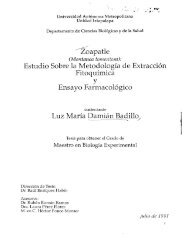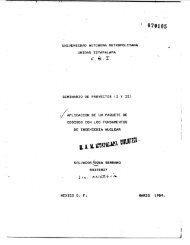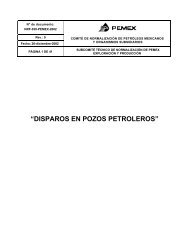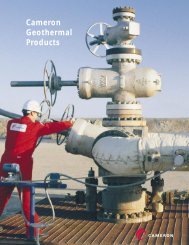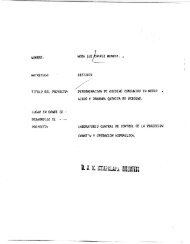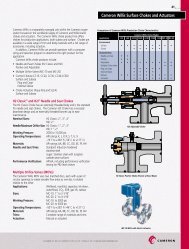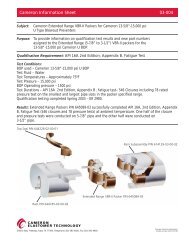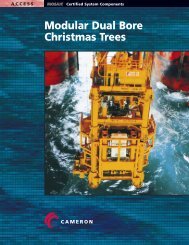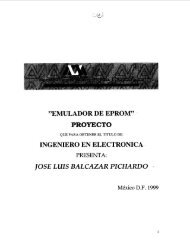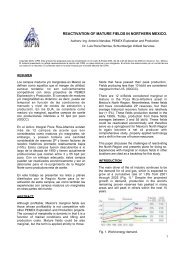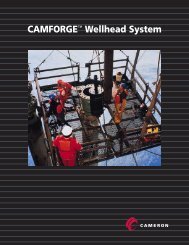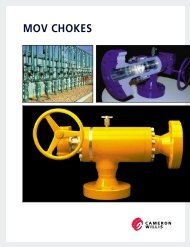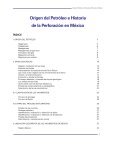Create successful ePaper yourself
Turn your PDF publications into a flip-book with our unique Google optimized e-Paper software.
Cameron Research <strong>Center</strong>
The Cameron Research <strong>Center</strong> offers our customers the most sophisticated research technology available in the industry today.<br />
Cameron’s Commitment to<br />
Technology<br />
Cameron designs and manufactures<br />
the most technologically innovative<br />
drilling and production equipment<br />
for onshore and offshore applications,<br />
for both surface and subsea.<br />
Through the years our wellheads,<br />
gate and ball valves, blowout preventers<br />
and pressure control systems<br />
have served the needs of the oil and<br />
gas industry around the world. We<br />
are committed to sustaining our<br />
leadership in the industry by aggressively<br />
pursuing new and innovative<br />
technological solutions for the markets<br />
we serve, now and in the future.<br />
Cameron’s New Research <strong>Center</strong><br />
The new Cameron Research <strong>Center</strong> is<br />
located on a 10.8-acre site in northwest<br />
Houston. The 53,000 square<br />
foot building houses Cameron’s<br />
Research and Development group, a<br />
complete state-of-the-art test laboratory<br />
and a dedicated Cameron<br />
Product Showcase.<br />
Cameron Research <strong>Center</strong> State-of-the-art Capabilities<br />
1 Pressure – Hydrostatic testing is performed using a variety<br />
of pumps which produce pressures up to 70,000 psig<br />
at flow rates up to 15 GPM. Gas testing of equipment<br />
such as valves and wellhead equipment is conducted in<br />
reinforced test cells with five nitrogen gas compressors,<br />
one electric and four air-driven, capable of generating up<br />
to 36,000 psig.<br />
4<br />
2<br />
3<br />
Bending – Bend testing capabilities for bending moments<br />
up to 3.6 million ft-lb are accomplished utilizing a<br />
hydraulic bend frame. The frame is typically used to test<br />
proprietary end connectors.<br />
Environmental – A hyperbaric chamber simulates<br />
subsea water depths in excess of 10,000 feet. It is used for<br />
testing valves or control system components. Additional<br />
equipment is capable of testing at temperature extremes<br />
ranging from -100 to 2000 o F. These units test parts from<br />
gate valves, chokes and wellhead equipment to BOPs and<br />
wellheads.<br />
Product Showcase<br />
The new Cameron<br />
Research <strong>Center</strong> is home<br />
to a dedicated Cameron<br />
Product Showcase, a venue<br />
for customers to view<br />
actual Cameron equipment.<br />
In addition, an interactive<br />
display allows customers<br />
access to the Cameron<br />
Internet Homepage.<br />
Featured products include<br />
anything from surface<br />
wellheads and Christmas<br />
trees to gate valves and<br />
drilling equipment.<br />
Product Showcase<br />
8<br />
Hot Oil<br />
Testing<br />
Product<br />
Showcase<br />
5<br />
6<br />
Fatigue – A load frame with a fixed tail stock and<br />
a rotating spindle is used for dynamic bend tests<br />
with up to 20,000 pounds of deflection load. It can<br />
handle test specimens of up to 19 feet and rotates<br />
at 12 RPM. The frame is suitable for testing equipment<br />
such as risers, wellheads and other dynamically loaded<br />
structures.<br />
Tensile – Strongback testing machine is used for conducting<br />
bend tests up to 14.7 million ft-lb and up to 1.0<br />
million pounds of axial load. This machine tests equipment<br />
such as flowline connectors, stress joints and large<br />
structural collet connectors.<br />
Underwater/Hazardous – Two 25-foot deep pits<br />
allow assembly of equipment such as BOP stacks, marine<br />
wellheads and subsea trees. Water flooding and test pit<br />
covers also assist in leak detection and blast containment.<br />
1 6<br />
Pressure Testing<br />
25’ Underwater<br />
Testing Pit<br />
10<br />
Pull/Push Load Cell Devices<br />
Electrical<br />
Room<br />
Environmental<br />
Testing Area<br />
3<br />
Tool Crib<br />
1<br />
7 Flow Loop – An 8000 gallon tank with a 500 horsepower<br />
11<br />
pump circulates water for flow characteristic<br />
testing on chokes.<br />
8<br />
9<br />
10<br />
Hydrostatic & Gas<br />
Pressure Testing<br />
Hot Oil – Circulating units for high temperature BOP<br />
or gate valve testing up to 600 o F simulates hot well<br />
fluids flowing through equipment.<br />
Erosion – A drilling and mud circulation loop<br />
simulates the effects on equipment of cuttings and<br />
sand flowing from up the well. It is capable of<br />
flowing up to 6 barrels per minute of drilling fluids<br />
at up to 4500 psig. The loop is used for erosion testing<br />
on chokes and on gate valves.<br />
Pull/Push Load Cell Devices – These devices are used<br />
for simulating tubing and casing loads on wellhead<br />
slips and hangers. They can also simulate drill pipe<br />
hangoff loads on BOPs. Loads up to 3 million pounds<br />
can be simulated.<br />
3<br />
Hyperbaric<br />
Testing Chamber<br />
Work<br />
Room<br />
9<br />
6 Erosion<br />
Testing<br />
25’ Underwater<br />
Testing Pit<br />
2<br />
Strongback Testing Machine<br />
Fatigue Testing<br />
4<br />
11<br />
Flow Loop<br />
7<br />
Salt Fog<br />
Test<br />
5<br />
Corrosion – A salt fog cabinet for elevated temperature<br />
corrosion testing evaluates the performance of coatings,<br />
platings, and corrosion inhibitors on a wide variety of<br />
products normally exposed to corrosive environments.<br />
Additional features of the new Test Lab include:<br />
• Six concrete test cells for high pressure/high<br />
temperature testing.<br />
• Remote visual and electronic data acquisition and<br />
monitoring of tests from instrument control rooms.<br />
• Enclosed 2500 square foot product demonstration area.<br />
• Climate controlled test bays.<br />
• Crane capacity of 50 tons.<br />
SD24541.97<br />
Dual large bore BOP stack.<br />
Titanium stress joint bend test.<br />
Research and Development<br />
Cameron maintains an active involvement<br />
in research and development<br />
through both corporate programs<br />
and joint activities with customers.<br />
Activities include new and existing<br />
product development; testing and<br />
analysis; process/equipment development<br />
and testing; and product<br />
performance improvement. In<br />
addition, Cameron engineers are<br />
continually at work on new ways to<br />
produce quality equipment at lower<br />
costs, and to improve equipment<br />
operating efficiency.<br />
The Cameron Research <strong>Center</strong>,<br />
the foundation of Cameron’s commitment<br />
to technological leadership<br />
and advancement, is the new home<br />
for Cameron’s Research and<br />
Development group. This group is<br />
made up of highly-trained and experienced<br />
engineers and designers<br />
involved in the development, design,<br />
analysis and testing of new products,<br />
product extensions or refinements.<br />
A crucial part of the Research<br />
and Development process includes<br />
Office<br />
Space<br />
Locker<br />
Rooms<br />
Liquid Nitrogen<br />
Tank<br />
product testing. Cameron’s new<br />
Research <strong>Center</strong> houses a complete<br />
The Cameron<br />
Research <strong>Center</strong><br />
Coffee<br />
Bar<br />
Research <strong>Center</strong> main testing area.<br />
test lab with the finest in state-ofthe-art<br />
testing facilities.
Cameron Research <strong>Center</strong><br />
6750 Bingle<br />
Houston Texas 77092<br />
Tel 713 369 4100<br />
Fax 713 369 4128<br />
www.camerondiv.com<br />
© Cooper Cameron Corporation, Cameron Division, Printed in USA, 7/98, TG/5M, <strong>WR6625</strong>/<strong>TC1281</strong>



